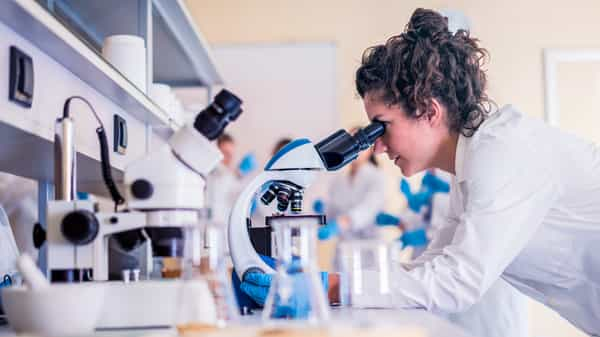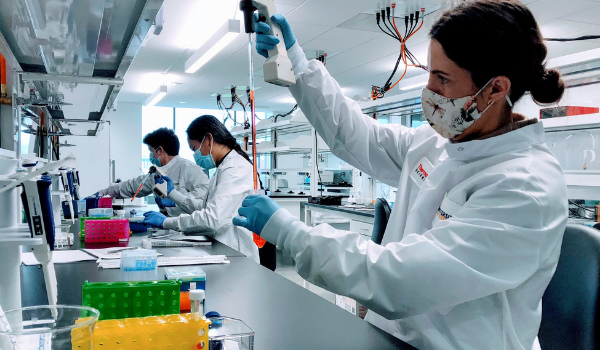Product development includes the early stages of research through post-market surveillance.
Other industries, however, may define product development as the process beginning at the point when a problem is identified and lasting until the product is on the market. This makes it more difficult for a biotech startup to understand product development, as the steps will be different depending on the company that is describing it.
Broadly speaking, many industries may define the stages of product development as the following:
This may also apply to medical device companies in some instances, but for biotech companies that are developing drugs and biologics, they tend to define product development in narrower terms.
In biotech, the stages of product development are commonly known to be the following:
These stages seemingly leave out aspects like market research, but the reality is more that market research is assumed to have been done before undertaking the preliminary research, and is fleshed out in other stages of product development.
🔬 Related: The Importance of Market Research in Biotech and Medtech Startups

An early-stage biotech company or the research and development department of a large pharma company will both undertake preliminary research to determine whether a drug, biologic, or technology can be utilized against a disease. This step requires translating the technology into a product.
In an early-stage biotech company, the technology may come from an academic lab in which a compound, biologic, etc. was found to interact with a known target for a particular disease. In this scenario, the preliminary research that the company would need to do would be to achieve “proof of concept,” and show that not only does the compound interact with the target, but that the interaction produces an effect on the disease state.
Because this work is preliminary, it is done in the most cost-effective way possible, usually first using an in-vitro model and then moving into animal models. These tests are usually performed in a research and development environment, which means that robust quality management systems are likely not in place, and studies take place on a small scale. Thus, preliminary research many only require very small amounts of the compound, biologic, etc. being tested. Depending on the difficulty of procuring this substance, future steps in the development of the product may be easier or more challenging.
If the original idea for the technology came from an academic laboratory, then product development may also depend on the status of patents and licenses for those patents. If a company does not have freedom to operate using the technology, they may have to invest significant resources into developing something that they own and can therefore take to market.
🔬 Learn: HealthTech-Focused Customer Discovery
-1.jpg?width=600&name=COVID%2019%20Clinical%20Trials%20Stock%20Photo%20(2)-1.jpg)
Preclinical testing is the phase of product development when a company must show that their proposed product is safe. They must also determine what the pharmacokinetics (PK) pharmacodynamics (PD) are. PK deals with what happens to a drug once it enters the body--how quickly is it absorbed, distributed, metabolized, and excreted. Kinetic refers to movement and pharma refers to drug, so it is the drug’s movement through the body. Pharmacodynamics deals with the interactions the drug has with the body and the resulting effects. This includes how the drug binds to receptors, the effect of receptor binding, and chemical effects. As this is still preclinical testing, initial PK and PD data is collected in animal models.
During preclinical testing is also a good time to define the target product profile, or TPP. TPP is the information that is found on a product insert or pamphlet detailing the use, indication, any contraindications, etc. of the product. The preliminary route of administration, dose, and dosing regimen must be determined in the animal model as well, so it can be planned out for clinical trials.
Also at this stage, biotech companies usually start to discuss chemistry and manufacturing controls (CMC). CMC ensures that the product that the company gets manufactured for clinical trials is the same as what is designed and authorized for those trials by the FDA. Depending on the product, its ability to be manufactured at a certain scale, or at all, may come into question, which is one reason why it must be addressed so early during product development. Another reason is that it can take 9-12 months to complete the work required to get from the CMC plan for the product to the actual manufacture of the product, which can easily disrupt clinical trial timelines. CMC deals with all of the practical aspects of making the product, such as its form, storage, and stability. A company must determine the stability and solubility of the product at this stage because if the product needs to be in solution but not enough of it can dissolve to be effective, then that’s a problem. Similarly, if the product is not stable in solution for a long enough period of time for it to be transported, that is also a cause for concern.
Studies done for the express purpose of convincing the FDA to approve the start of clinical trials in humans are called Investigational New Drug (IND)-enabling. These studies must be done under Good Laboratory Practices (GLP), which are principles defined by the government and used to ensure that non-clinical laboratory studies are valid and reliable. GLP requires that a robust system for managing quality be in place, so often small or startup biotech companies will outsource these experiments to contract research organizations (CRO’s).
🔬 Related: How to Choose the Right CRO
Also in preparation for submitting an IND, companies must create a clinical program that details how the initial clinical trial will be carried out. This is another piece that can be outsourced to CRO’s that specialize in developing clinical programs. Clinical trial design must answer the following questions in order to fulfill the FDA’s requirements for an IND submission:
Although at this stage market research has already been done, the time is ripe for another look at the market do determine financial viability. Since CMC has been completed, the company will know much more about how much producing the product will cost, so it behooves a company to make sure that these costs still allow room for profit in the current market. The product must work, but it also needs to be profitable in order for the company to survive.
Finally, a company that has completed their preclinical studies, CMC, and clinical program can apply for an IND. IND is the method by which both drugs and biologics are presented to the FDA to begin clinical trials.

Once a startup has received approval from the FDA to begin clinical trials for their product, they progress through a series of phases depending on how their product fares. These phases are:
Phase 1: This first trial’s main purpose is to determine that the product is safe for use in humans. The number of participants is kept as small as possible, and may be limited to patients who are farther along in a disease state or who have exhausted other options for treatment.
Phase 2: The second phase continues to confirm that the product is safe, but also utilizes sufficient participants to determine what an optimum dose and regimen are.
Phase 3: This (usually) last phase of the clinical trial is designed to determine whether the treatment is truly effective, and is expanded to include enough people such that potential side effects are more likely to be captured in the data.
🔬 Related: Rules of Clinical Engagement for Healthcare Startups
The biologics license application (BLA) is the process by which a biologic that has successfully completed clinical trials applies to the FDA to be sold to the public. A new drug application (NDA) is the same process but for pharmaceuticals.
A BLA is submitted to the Center for Biologics Evaluation and Research and must include the preclinical data, clinical data, manufacturing information, information about the applicant, and labeling information for the product.
An NDA similarly must include the drug’s whole story, from preclinical history to clinical data to manufacturing processes, plus label information and information about the company applying to sell it.
Finally, after the drug or biologic is on the market, the FDA requires that companies continue to collect and submit data regarding any adverse effects of the product. Since clinical trials cannot cover every eventuality in terms of circumstances, disease states, other concurrent medications, etc. that could cause an adverse reaction to their product, these potential risks must be monitored for the safety of the consumer.
Additionally, the FDA needs to know if any changes are made to an already submitted NDA or BLA. For practical reasons, a company might need to change suppliers for one of the product’s components, change manufacturing processes, or change manufacturers altogether. The FDA allows for this but these changes must be reported so they can make sure the consumer is still protected from potential harm.
Download The Ultimate Guide to Wet Lab Incubators in Southern California, a handbook to assist life science start-ups through the entire decision-making process to find wet lab space.
Download Now